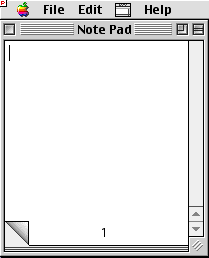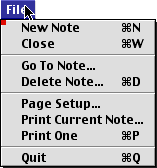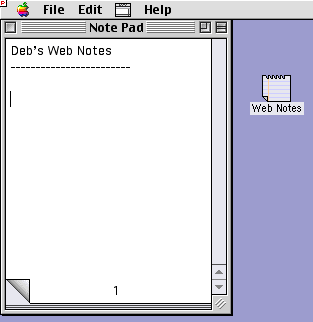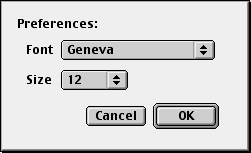Note Pad Tricks
Written and published January 19, 2000
Well, here we are in Y2K. Along with a record-breaking number of Mac users I had the opportunity to start this year off with a good look at what our beloved, dedicated hardware and software vendors have been working on and see some nice new things. Of course, as I get to know this stuff I'll share it all with you. But perhaps somewhat ironically, rather than start the new year off with something high-tech, I'm starting with what is perhaps the most simple and humble of all Mac applications. The Note Pad.
You've probably taken a look at the Note Pad at some point. It's conveniently located right under your Apple Menu so if you're the inquisitive type you've opened it. Perhaps you've typed a note or two. From there either you got hooked on it, or noting that everything on it is in one big pad and you had no saving control, dismissed it. Personally, I was hooked. The Note Pad is a tiny app, at only about 68k, so it opens quickly. It's simple and pretty straight forward. But I did find it limiting -- until I discovered a few tricks. This week I will share those tricks with you. Perhaps you'll find the Note Pad helpful after today.

About the Note Pad
The Note Pad, although not placed by the Mac OS installer in the Applications folder, is actually an application. That's because it goes back to the early days of the Mac, back when you couldn't run more than one program at once. Back then, small applications called Desk Accessories, or DAs, were created and placed under the Apple Menu because they could be opened and used while you were using a full-fledged Mac application.
There are two ways to see for yourself that the Note Pad is an application:
* You can view the Apple Menu Items folder as a list and look under the Kind column. If Kind isn't showing, choose View->View Options, and check Kind in the resulting dialog box. When you close the dialog you'll see the Kind column. In the row about the Note Pad you'll see the words, "Application Program."
* Or, you can click on the Note Pad application once to select it, then choose File -> Get Info. (You can also choose File -> Get Info -> General Information but that's not necessary as General is the default information screen.)
Since the early days, the Note Pad has gone through a few revisions, gaining a bit more functionality. Although an application, the Note Pad functions a bit differently from other programs. For example, launch it (Choose Apple -> Note Pad) and you'll notice that it doesn't have a Save.

The first time you launch the Note Pad it automatically creates a file called "Note Pad File." However, instead of asking you where you'd like to save that file, it's automatically saved directly within the System Folder -- look in your System Folder and you'll probably see that file. Each time you choose and use the Note Pad, that file is amended. The idea is simple. You have a place to take notes, copy thoughts to, etc. But, what about backup? It's stored in the System Folder. Do you back up your full System Folder every time you make a note? I'm guessing not -- even if you're very good about backing up. And that's not good because computer-wise, there's nothing worse than losing all your notes or information.
Using Note Pad Efficiently
One of the apparent downsides of the Note Pad is the lack of ability to create separate documents. But the truth is that you can make as many separate note pads as you wish. For example, I have one just for Web notes, one as my To Do list, another for ... well, that's not important. What is important is that you can have one for every purpose you can think of.
Here's how:
1. Open your System Folder and locate the document called "Note Pad File." If you don't have this file, choose Note Pad from the Apple Menu. As soon as the Note Pad opens, the file will appear in the System Folder. Close the Note Pad.
2. Move the Note Pad File out of your System Folder and onto your Desktop.
3. Rename the Note Pad File, giving it a descriptive name. For example, Web Notes or To Do.
4. Double-click the newly named Note Pad File to open that Note Pad. At the top of the pad, type a descriptive title. Unlike other documents, a Note Pad's window title bar will always just say Note Pad, rather than taking on the name you give the file so typing a name on the pad really helps. Use the underline/hyphen key to create a line to divide the title from the notes that will follow, if you'd like. Then hit return to place the cursor on a new line.

5. The above screen shot shows a renamed Note Pad File with my title. Beside the Note Pad, you can see the actual file on the Desktop
6. Close that Note Pad.
7. To create another Note Pad, choose the Note Pad from the Apple Menu again. This creates yet another Note Pad File in your System Folder. As long as there is no Note Pad File in the System Folder, choosing this application will always generate a new file. We're using this to our advantage here.
8. Repeat steps 2-5 for the new Note Pad File.
9. For each Note Pad you'd like to create, repeat step 6, then steps 2-5.
10. Now that you have all of your note pads, you'll have to consider where you'd like to store each of your Note Pads. You can store them all in one folder, or store each where it is most appropriate. Then, for easy access you'll want to put an alias of each under the Apple Menu.
Back in March '99, in Dealing With Data Files, I suggested moving your important data files into a folder called "My (Your name) Personal files." You might move these note pads into that folder. If you create a folder called Note Pads within your personal files folder, put all pads there, then you can make an alias of that folder and simply place that alias into the Apple Menu Items Folder.
Open the Apple Menu Items Folder and make a folder in it called Note Pads. Then place an alias of each note pad into this folder. That way you can access all of your notes easily by topic. Then move your Web note pad into your personal files folder. I have a folder just for my own Internet settings so I might keep my Web note pad in that folder.
Place the alias of your Web note pad into your Internet applications folder under the Apple menu. But before you place the actual note file in your Internet applications folder in your hard drive, remember that you don't often back up your application folders.
Finally, since the Note Pad is an application, consider moving it from the Apple Menu Items Folder into your Applications folder. That way you're less likely to select it and inadvertently store your person data/information within your System Folder.
Now, whenever you want to make a note open the actual Note Pad File (now renamed). For example, for a note about the Web, just choose the Web Notes note pad from the Apple menu. My own Web Notes Note Pad contains my usernames, passwords and such so I can get to them easily.
Some things to know about the Note Pad:
1. There is no save. Notes are saved automatically. Just to be sure it saves, don't keep it open a long time. After you add something important, consider closing it. You can then re-open it.
2. To turn pages, click the bottom left corner.
3. To add a new page, choose File -> New Note (Command-N)
4. You can print your notes.
5. Only one note pad can be open at a time. Opening a second one automatically closes any open one.
6. You can delete or edit any text on a page.
7. Delete Note will delete an entire page of notes -- it'll delete whatever page you're on when you choose this command.
8. There's a Quit command but it's not necessary to use. Closing a Note Pad's window quits the application.
9. You can change the font and size. Choose Edit -> Preferences. Actually, that's the only Preference there is.

Note: A To Do Note Pad isn't the only way to go. Months ago we discussed clipping applications that will do the job well. And then there's Simple To Do, by Henry Carstens. It's on my list of things to show you someday but you may want to look at it on your own right now.
|



